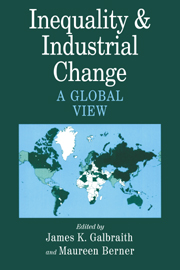Book contents
- Frontmatter
- Contents
- Contributors
- Permissions
- Acknowledgments
- PART I INTRODUCTION TO THEORY AND METHOD
- PART II INEQUALITY, UNEMPLOYMENT, AND INDUSTRIAL CHANGE
- 3 The American Wage Structure: 1920–1947
- 4 Inequality in American Manufacturing Wages, 1920–1998: A Revised Estimate
- 5 Interindustry Wage Structures: New Evidence from the OECD
- 6 Inequality and Unemployment in Europe: The American Cure
- PART III INEQUALITY AND DEVELOPMENT
- PART IV METHODS AND TECHNIQUES
- Data Appendix
- References and Selected Bibliography
- Index
3 - The American Wage Structure: 1920–1947
Published online by Cambridge University Press: 05 June 2012
- Frontmatter
- Contents
- Contributors
- Permissions
- Acknowledgments
- PART I INTRODUCTION TO THEORY AND METHOD
- PART II INEQUALITY, UNEMPLOYMENT, AND INDUSTRIAL CHANGE
- 3 The American Wage Structure: 1920–1947
- 4 Inequality in American Manufacturing Wages, 1920–1998: A Revised Estimate
- 5 Interindustry Wage Structures: New Evidence from the OECD
- 6 Inequality and Unemployment in Europe: The American Cure
- PART III INEQUALITY AND DEVELOPMENT
- PART IV METHODS AND TECHNIQUES
- Data Appendix
- References and Selected Bibliography
- Index
Summary
This chapter uses industrial wage data to examine changes in the interindustry structure of wages between 1920 and 1947. We first sort among the available data on wage changes by industry and occupation to identify blocs that exhibit common patterns of wage change over time. We then analyze the sources of wage variation across groups and through time. We identify four such forces that together explain 97 percent of the variance in wage change across groups, and we identify variables in the historical record that appear to correspond to these forces. In a reversal of the usual notions of micro-to-macro causality, we argue that a small number of macroeconomic variables thus account for a large proportion of distributional changes.
Introduction
Impressed by the sweeping implications of the mind–body problem, the German philosopher Arthur Schopenhauer referred to that famous conundrum as the Weltknoten, the “World Knot.” Economic history is more prosaic. Yet the economic experience of the United States between World War I and the end of World War II did generate one problem with nearly as sweeping repercussions in its field: the behavior of wages.
This period spans the slump following World War I, the Roaring Twenties, the Great Depression, the New Deal, and World War II – times of turmoil encompassing every form of economic, technological, political, and social change. Studies of wage determination during this time can therefore illuminate many competing hypotheses, perhaps more effectively than studies of the allegedly more tranquil postwar period.
- Type
- Chapter
- Information
- Inequality and Industrial ChangeA Global View, pp. 33 - 78Publisher: Cambridge University PressPrint publication year: 2001
- 1
- Cited by



